#German enamelware
Explore tagged Tumblr posts
Text
When “all the gates of compassion seemed to have been closed”, what is to be done?

Winner of seven Academy Awards, including Best Picture and Best Director, Schindler’s List is the incredible true story which follows the enigmatic Oskar Schindler (Liam Neeson), who saved the lives of more than 1,100 Jews during the Holocaust.
It is the triumph of one man who made a difference and the drama of those who survived one of the darkest chapters in human history because of what he did. Schindler’s List is a powerful story whose lessons of courage and faith continue to inspire generations.
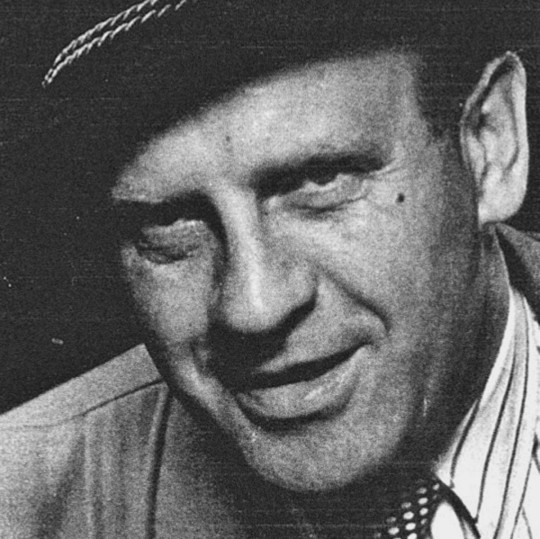
Following the Nazi invasion of Poland, Oskar Schindler, a German Catholic industrialist, moved to Kraków and assumed responsibility for the operation of two formerly Jewish-owned manufacturers of enamel kitchenware. He then established his own enamelworks in Zabłocie, outside Kraków. That factory became a haven for about nine hundred Jewish workers, providing them relief from the brutality of the Płaszów labor camp nearby.
In October 1944 Schindler was granted permission to relocate his defunct enamelworks to Brünnlitz, Czechoslovakia—this time as an armaments factory—and to take with him the Jewish workers from Zabłocie. He succeeded in transferring to Brünnlitz approximately eight hundred Jewish men from the Gross-Rosen camp and three hundred Jewish women from Auschwitz, ensuring their humane treatment and, ultimately, saving their lives.
In 1962, Yad Vashem awarded Schindler the title “Righteous Among the Nations” in recognition of his humanitarian contribution, and in 1993, the United States Holocaust Memorial Council posthumously presented to him the Museum’s Medal of Remembrance. This medal, rarely presented, is intended to honor deserving recipients for extraordinary deeds during the Holocaust and in the cause of Remembrance. Emilie Schindler accepted the medal on behalf of her husband at a ceremony in the Museum’s Hall of Remembrance.
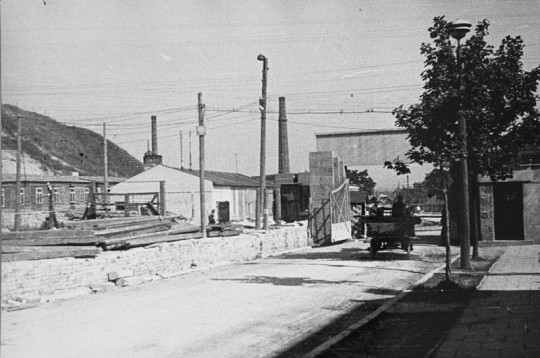
The Płaszów camp was established in 1942 under the authority of the SS and police leaders in Krakow. It was initially a forced-labor camp for Jews. The original site of the camp included two Jewish cemeteries. From time to time the SS enlarged the camp. It reached its maximum size in 1944, the same year that it became a concentration camp. Until that time, most of the camp guards were Ukrainian police auxiliaries chosen from among Soviet soldiers in German prisoner-of-war camps and trained at the Trawniki training camp in Lublin.
The German industrialist Oskar Schindler established an enamelware factory in Krakow, adjacent to Płaszów. He attempted to protect his Jewish workers, some 900 people, from abuse in Płaszów and from deportation to killing centers. When he moved the factory and his Jewish work force to the Sudetenland in 1944, he prevented the deportation of more than 1,000 Jews.
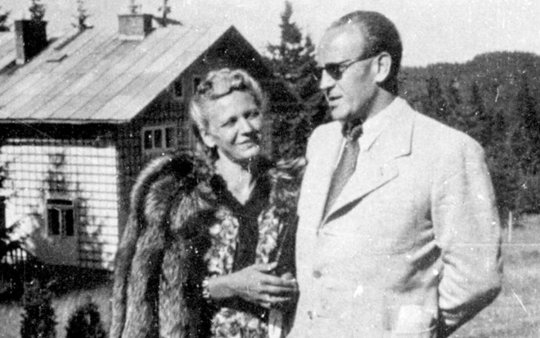
It soon became clear that her marriage would have both its passions and its betrayals. Yet Emilie stayed with Oskar through his growing involvement with the Nazis, working for counterintelligence with him. She first, then he later, came to realize the costs of the Nazi takeover and became witnesses to its terrors.
Through their work together at their two factories, saving the Jews became paramount for the Schindlers. Emilie nursed the Jewish factory workers when they fell ill, often saving their lives. She risked imprisonment or worse for her activities in the black market to feed them.
Where Light and Shadow Meet chronicles the Schindlers' flight after the war, the loss of almost all their possessions, and their eventual emigration to Argentina. There they settled on a farm, but barely scraped together an existence. Oskar returned to Germany, leaving Emilie to manage on her own. This is the story of one woman's daily acts of bravery during Hitler's reign and why it mattered.
#schindlers list#Holocaust Memorial Day#United States Holocaust Memorial Museum#hmd2023#manchester#education#oskar schindler#emilie schindler#ww2 history#uk#ww2 education#argentina#yad vashem#social media#books#book club#bookshops#germany#europe#media#film#BBC News#bbc iplayer
12 notes
·
View notes
Text
EMILIE SCHINDLER // RESISTANCE FIGHTER
“She was a Sudeten German-born woman who, with her husband Oskar Schindler, helped save the lives of 1,200 Jews during WWII by employing them in his enamelware and munitions factories, providing them immunity from the Nazis. When conditions worsened and they started running out of money, she sold her jewels to buy food, clothes and medicine. She looked after sick workers in a secret sanatorium in the camp in Brnenec, Czech Protectorate, with medical equipment purchased on the black market. She was recognised as Righteous Among the Nations by Yad Vashem in 1994.”


0 notes
Text

OSKAR SCHINDLER
1908-1974
Oskar Schindler was a German industrialist, humanitarian, and member of the Nazi Party who is credited with saving the lives of 1,200 Jews during the Holocaust by employing them in his enamelware and ammunitions factories in occupied Poland and the Protectorate of Bohemia and Moravia.
#oskarschindler
0 notes
Link
Check out this listing I just added to my Poshmark closet: World Market Vintage Porcelain Flour Canister Storage Farm House Country EUC.
0 notes
Text
Schindler's List
On the 1982, Schindler's List recreates the true story of Oskar Schindler, the Czech-born southern German industrialist who risked his life to save over 1,100 of his Jewish factory workers from the death camps in Nazi-occupied Poland. Thomas Keneally's "documentary novel", based on the recollections of the Schindlerjuden (Schindler's Jews), Schindler himself, and other witnesses, is told in a series of snapshot stories. It recounts the lives of; the flamboyant profiteer and womanizer Schindler, Schindler's long-suffering wife, named Emilie, the brutal SS (Nazi secret service) commandant Amon Goeth, the Schindler's silent yet courageous factory manager, Itzhak Stern, and dozens of other Jews who underwent the horrors of the Nazi machinery. At the center of the story, though, are the actions and ambitions of Schindler, who comes to Kraków, Poland, seeking his fortune and ends up outwitting the SS to protect his Jewish employees. It is the story of Schindler's unlikely heroism and of one man's attempt to do good in the midst of outrageous evil. The book explores the complex nature of virtue, the importance of individual human life, the role of witnesses to the Holocaust, and the attention to rules and details that sustained the Nazi system of terror. Keneally's book was first published in Britain in 1982 under the title Schindler's Ark and released as Schindler's List in the United States the same year. In Schindler's List, Keneally illustrates a portrait of a human being who discovers the joy in giving all he has to save the lives of others.
Oskar Schindler, the protagonist of the film, is a businessman who sees an opportunity to take advantage of the current circumstances in Krakow. Schindler uses his charismatic personality to gain respect amongst the Nazi party and in return, he is allowed to start an enamelware factory. He enlists a large group of Jews to work for him and because of their involvement, they become immune from concentration camps. The success of the enamelware factory begins to decline as the antagonist Lieutenant Goth arrives in Krakow with the orders to construct a new concentration camp. Schindler is exposed to the horrific crimes done by Goth as he violently mistreats and kills the workers of the camp with no remorse. This changes the perspective of Schindler and his motives for capital gain shift to the focus of protecting his workers.
Soon the Germans become worrisome that defeat is starting to look imminent. Nazi officials order all remaining Jews in Krakow, including Schindler's workers, to be shipped to Auschwitz death camp. Schindler is forced to exhaust his remaining savings to offer a bribe for Goth in hopes of protecting his workers. Regardless of the bribe, Schindler's Jews are mistakenly routed to Auschwitz and Schindler is forced to offer an additional bribe that would allow him to create an ammunition plant for his workers. At the end of the war, Nazi soldiers are ordered to kill all remaining Jews in Schindler's factory. He makes a desperate attempt to persuade the soldiers to leave with dignity and is successful in liberating his workers. The Schindler Jews provide Oskar with a document attesting to his acts of protection as it allows him to avoid future arrest. The Krakow Jews show their gratitude to Schindler but he is conflicted with internal sorrow as he realizes his greedy endeavors could have been channeled to save more lives.
Schindler’s List explored the journey of Jews in Nazi Germany and the compassion of one German man saving over a thousand Jewish lives. The eerie black and white setting, with an unforgettable glimpse of red, and the morbid classical music throughout the film combine to communicate these themes.
Most people deem black and white movies as boring because of all the black and white films created in the early 20th century. However, limiting the colors of a movie on purpose delivers a statement more powerfully than stating it directly. Although a “black and white” film actually consists of an infinite amount of gray shades, the real purpose of the disuse of colors is to set the depressing mood before the sad events even begin. Shadows are magnified because they are one of the only colors used in the movie. Happiness is difficult to portray without color; the gray shades suggest a depressed individual’s perspective of the world. It also makes use of the audience’s prior knowledge that old movies did not have color to suggest that the events of the movie took place in the past. The terrible reality of these events combines with the extremely glum mood to evoke an overall distraught emotion from the audience. A viewer can grasp all of this from the black and white filter alone.
The Nazis prove the discouraging truth that even the best of peoples have a beast inside and must stand guard lest it escape. But Oskar Schindler proves the redeeming truth that even the weakest of us has a hero inside. Just because the worst happens doesn't mean that the best within us cannot rise to the surface and do its duty. ‘Schindler’s List’ is an important film in society because it emphasizes marginalization, genocide, and individualization.
1 note
·
View note
Text
Vintage Kitchen Enamelware
Inexpensive and easy to clean, enamelware kitchen and household items were very commonplace for more than a hundred years. I first noticed enamelware items such as coffee pots in Western films and television programs when I was a child. I also sometimes saw an enamel pan or two in stores that sold camping supplies. When my fascination with vintage kitchen things continued as a young adult, I learned more about enamelware, and discovered charming European pieces I had never seen before. In recent times, Farmhouse and Country French interior decorating trends have kindled popular interest in vintage enamelware.
Vitreous enamel, often called porcelain enamel, is made by fusing a thin layer of powdered glass to a surface capable of withstanding the high temperature firing process. The receiving metal, glass, or ceramic surface is called a substrate. The powder melts, flows, then cools, creating a hard, smooth coating.
Enameling has been done for centuries. It was mainly used for decorative objects and jewelry until the 1800s, when manufacturers began producing enamel cookware, sinks, bathtubs and other consumer items.
Enamelware kitchen items were developed in Europe, then came to North America in the mid 1800s. The earliest pieces were solid color, then speckled and marbled surfaces were introduced. By the late 19th and early 20th Centuries some enamelware had floral designs or decorative patterns and lettering. After World War II a variety of other materials took over much of the kitchenware market share, but enamelware kitchen utensils never completely disappeared. Enamelware cookware and colanders are still made and sold today.
Below are photos of various vintage enamelware pieces, followed by links for more information.
Because enamelware was relatively cheap and widely available, it was found in many modest homes. Appreciating the beauty and functionality of older pieces also makes me feel a connection to the lives and labor of the people who owned and worked with them.

Vintage blue graniteware colander. (Seller dated it to the 1920s.)

Vintage grey graniteware enamel funnel.

Vintage floral enamelware.

Vintage or antique French enamelware salt box.

Vintage French enamelware match holder. Matches were a kitchen essential for homes with cast iron wood-fired stoves. Matches were still needed for the first generations of gas stoves that followed (made from enameled steel). For decades gas stoves had pilot lights that had to be lit with each use.

Vintage French enamelware utensil rack with a floral motif. I have seen many of these, often dating from the 1920s to the 1940s.

Vintage French yellow and white enamelware salt box and utensil rack.

Vintage blue and white enamelware utensil rack.

Vintage French enamelware red and white utensil rack.

Vintage white and blue enamelware utensil rack, pans, and pitcher.

Antique or very vintage German enamelware holder for soda, sand, and soap, important household cleaning products in the first part of the 20th Century.

Vintage or antique German enamelware sand, soda, and soap rack. Although having a special place – almost a shrine! – for these three ingredients was something primarily German and Dutch in the early to mid 1900s, at the time these were staple cleaning products throughout Europe and America.

Vintage Dutch enamelware “Zand, Zeep, Soda” rack, circa 1950s.

Vintage enamelware rack of “Measuring Spoons’ that are actually little ladles.

Vintage (1940s) cream and green enamelware bread bin.

Vintage cream and green enamelware sauce pan.

Set of white and black enamel pans.

Mid-Century white and black refrigerator pan.

Vintage red and white square enamelware pan, 1950s.

In the 1950s and 1960s, movies and television programs about cowboys in the Old West were in demand. Monterrey Western Ware, a popular line of enamelware dinnerware made in Mexico, was introduced in the 1960s.

Vintage Monterrey Western Ware enamelware dinner plate with a chuckwagon illustration, surrounded by cattle brand motifs. Western movies made the chuckwagon cook, feeding cowboys on the open range, an iconic image of the Old West.

Vintage brown marble enamel coffee set. Each cup holds two cups of liquid.

Vintage white with blue trim enamel bain marie sauce pan. It was used over a pan of boiling water to prepare sauces or melt chocolate.

Vintage enamelware coffee pot with rooster design, circa 1960s or 1970s.

Set of white and green enamel cookware, circa 1960s or 1970s.

I have a vintage yellow enamelware stock pot like this, bought second hand for a few dollars twenty years ago. Luckily I acquired many of my vintage items before “farmhouse” décor became popular.
Good histories of enamelware are available on line, including the Collector’s Weekly website. The article linked includes information on dating pieces.
The Old and Interesting website article has details about the evolution and drawbacks of earlier enamelware, and a timeline of its history.
Martha Stewart gives a nice concise history of enamelware in America, along with advice on collecting and caring for enamelware.
#vintagekitchen#vintage enamelware#enamel kitchenware#enamelware#porcelain enamel#vitreous#graniteware#colander#vintage enamelware utensil rack#salt box#match holder#French enamel#French enamelware#German enamelware#soda sand soap#soda sand seife#enamelware pan#Monterrey Western Ware#chuckwagon#bain marie#coffeepot#stockpot#country french#farmhouse#funnel
2 notes
·
View notes
Photo



"I just couldn't stand by and see people destroyed. I did what I could, what I had to do, what my conscience told me I must do..." - Oskar Schindler, Righteous Among the Nations.
Oskar Schindler was a German industrialist and a member of the Nazi Party who saved the lives of 1,200 Jews during the Holocaust by employing them in his enamelware and munitions factories near Krakow. These Jews were registered on what came to be known as "Schindler's List".
Thousands of descendants of "Schindler's Jews" are alive today thanks to his brave actions.
Oskar Schindler died #OTD 9 October 1974 in Germany, and is buried in Jerusalem. Before his death, a tree was planted in his and Emilie's honor in Yad Vashem's Avenue of the Righteous. He is pictured below standing next to his tree on Yad Vashem's campus.
Oskar and Emilie Schindler are among the 27,000+ heroic non-Jews recognized by Yad Vashem as Righteous Among the Nations for risking their lives to rescue Jews during the Holocaust.
Yad Vashem: World Holocaust Center, Jerusalem
75 notes
·
View notes
Photo

Photographer Anne’s 150 yr. old cottage, is in a very rural part of Germany. (Rural places make this city girl nervous.) The cottage was last remodeled mid-century and she has no plans to remodel. Currently, it doesn’t have a bathroom (Anne built a composting toilet in the garden outhouse) or warm running water, so for now, it’s best for weekend visits and short-term stays.

Original details include blue tile, a painted staircase (ladder), and a door from the early twentieth century, adjacent to one from the midcentury-era remodel.
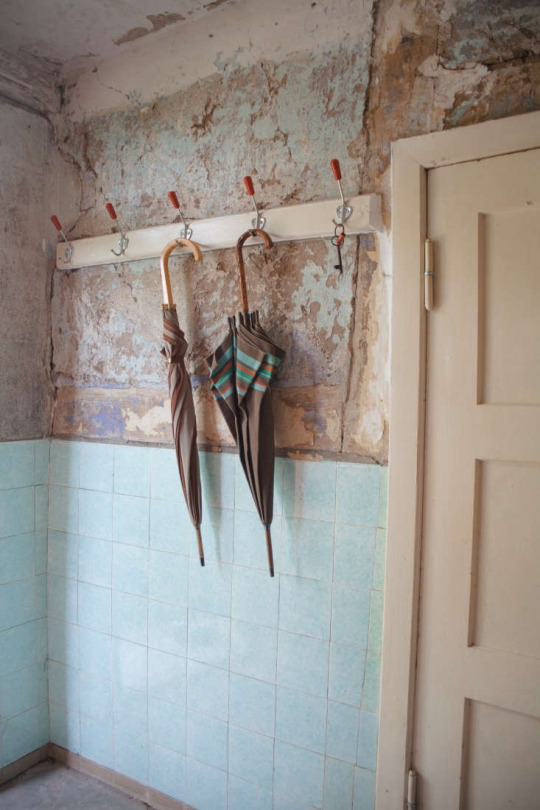
A rail of hooks from the hardware store and two umbrellas from a German flea market.

The upstairs crawl space where Anne sleeps is pretty cozy, and it’s not dreary- gets the morning sun, just fine.
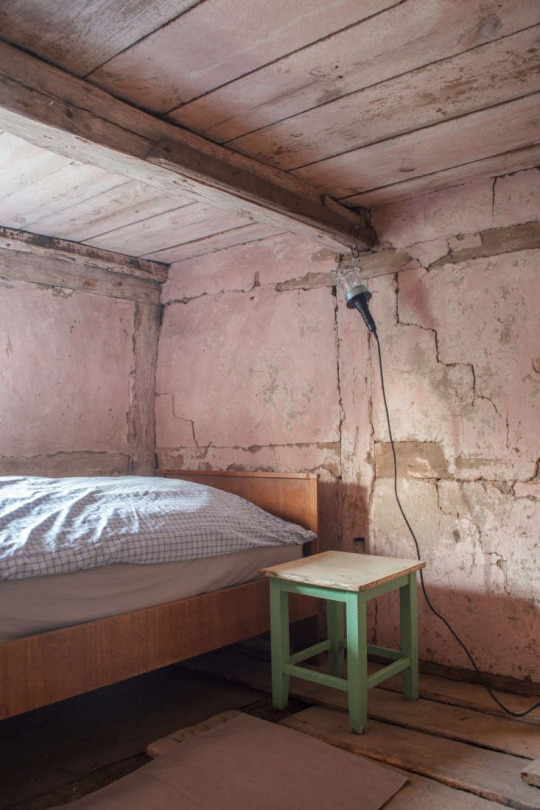
An industrial work light hangs from an S-hook above the bed in this room. The walls in this house are incredible, and look at the floor!
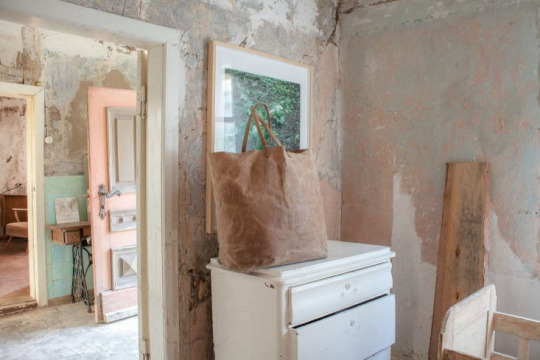
Anne, who likes “simple, good things,” and doesn’t “need new things all the time,” has a collection of items throughout the house, each with a different story. The paper-bag-looking tote on the dresser is made by Japanese artist Kazumi Takigawa from waxed canvas dyed with tea and coffee. I’m lovin’ the peach & gray front door, too.

The main bedroom downstairs is furnished with a vintage crib from Anne’s sister and a bed frame from a toy maker in the north of Germany. It’s very short, Anne explains, so tall guests have to sleep at a diagonal.

A single sprig from the garden in a handmade vase. The vintage lamp was found at the flea market.
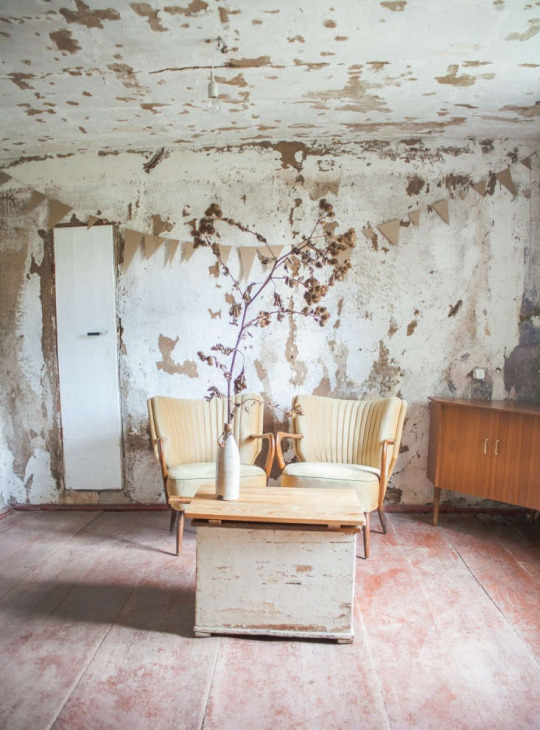
The living room has two antique armchairs, a midcentury bureau, and a chest used as a coffee table. The chest is from Anne’s great aunt, who once used it to store coal in her Berlin flat. The funny skinny door, Anne thinks, was used between sections of the cottage back when two families would inhabit the same house; “but I have no idea why it’s so small,” she says.

Anne bought the house from the daughter of a stove maker, who lived in the house after her father passed away. That explains this beautiful blue stove. Anne had a friend help her reconnect the stove to the chimney to get it working again.

Anne mixes a German rustic palette of browns and yellows with bright bits of pastel enamelware in the pantry-like space near the kitchen.

Two aluminum industrial shelves are filled with found ceramics (“I really have a thing for old stoneware pottery,” she says) and also some handmade by Anne. All the enamelware in her kitchen is bought from various flea markets.

Most of the furniture in the house Anne found in the storage shed; some of it was repainted.
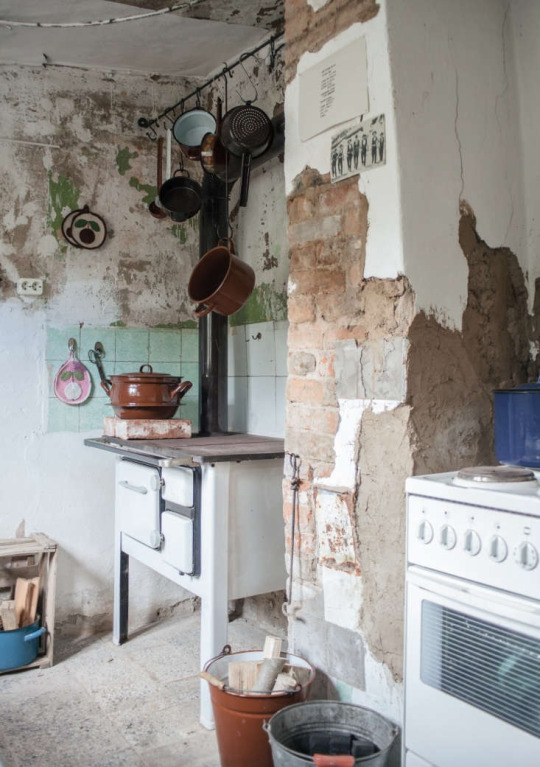
The rack above the stove is custom made from a blacksmith at the village’s Christmas market. The pot holders are made by a local woman who sells them in the village floral shop.
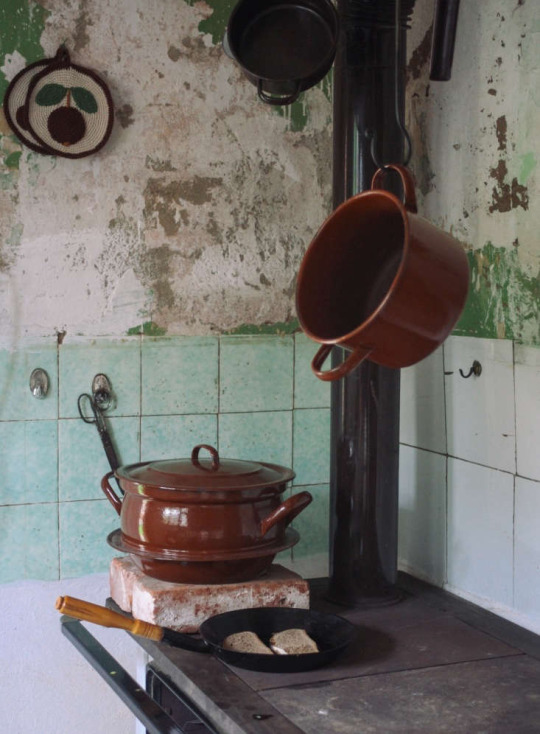
Anne builds a fire in the old stove first thing in the morning to warm up while she cooks breakfast on the cast iron stovetop. She bought the stove from a flea market vendor she shops with often.


This is wonderful. The mug and the plates are Anne’s handmade ceramics and the salt pot is from a friend in Berlin. It’s inspired by 19th century shoe polish pots.

The gray fabric used as a curtain is a moving blanket from the hardware store. Love this house so much!
https://www.remodelista.com/posts/anne-schwalbe-country-cottage-rural-germany-farmhouse/
256 notes
·
View notes
Text
Schindler's List (1993); AFI #8




The next film on the list that we watched is what I consider to be my favorite American film, Schindler's List (1993). It is very historically accurate for a big Hollywood drama due to the anal retentive love of history by director Steven Spielberg and the surprisingly large amount of source materials and first hand accounts. A large collection of the people portrayed in the film were consulted and direct family were consulted in the case of many others. It is a powerful film that was nominated for 12 Academy Awards and took home 7 of them. There were no acting wins for this film because it is one of the few Hollywood films that I have seen that leaned almost completely on the atmosphere and the setting. It is a very long film but remains intensely engaging for the entire run time, which I find is very rare after reviewing so many epic dramas over the last couple of years. I want to give a brief summary before singing more of the film's praises, so let me get the warning out of the way...
SPOILER WARNING!!! YOU COULD LITERALLY LEARN A LOT OF THIS INFO FROM A EUROPEAN HISTORY COURSE, BUT THE LITTLE DRAMATIC DETAILS ARE PARTICULAR TO THIS FILM!!! I PLAN TO SPOIL THIS SO BE WARNED OF SPOILERS BEFORE GOING FORWARD!!! I DON'T BLAME YOU IF YOU WANT TO WATCH THE FILM BEFORE READING ANY FURTHER!!!
---------------------------------------------------------------------------
The film begins in Krakow In 1941 when the Polish Jews were forced into the overcrowded Kraków Ghetto by the Germans. It is early on in World War II, and the Nazi party seems to present great business opportunities for many Germans. Oskar Schindler (Liam Neeson), a German from Czechoslovakia, arrives in the city in hopes of making his fortune by selling essential products to the Nazi party using the cheap labor of the oppressed Jewish people. It is made clear early on that Schindler is out to make a spectacle of himself by throwing his money around so he can gain a reputation with the German military making it easier for him to get what he wants. It's also made clear that he is a womanizer and will take advantage of his power to attract women. As a donating member of the Nazi Party who pays ridiculous amounts of money to give local officers a great night out, Schindler bribes members of the Wehrmacht (German armed forces) and SS officials, acquiring a factory to produce enamelware. With his new connections, Schindler attempts to undercut other suppliers by hiring Itzhak Stern (Sir Ben Kingsley), a Jewish official with contacts among black marketers and the Jewish business community. Stern tells Schindler that Jews are cheap labor and then ensures that as many Jewish workers as possible are deemed essential to the German war effort to prevent them from being taken by the SS to concentration camps or killed. Meanwhile, Schindler maintains friendly relations with the Nazis and enjoys wealth and status as "Herr Direktor".
Things are very rough and Schindler realizes that his work force can be reduced by summary executions in the street by Nazi soldiers and so dissuades the practice by having the government pay for any lost workers as they have been deemed essential. This makes his business a safe place for many Jewish non-laborers who would otherwise have been killed. However, SS-Untersturmführer (second lieutenant) Amon Göth (Ralph Fiennes) arrives in Kraków to oversee construction of the Płaszów concentration camp. He is quickly depicted as being a living Satan and his biography seems to reflect that. In 1943, when the camp is ready, he orders the ghetto liquidated and this is absolute chaos. Any dissidents are killed in the streets and anyone attempting to hide is killed. Over two thousand Jews are transported to Płaszów, and two thousand others are killed in the streets by the SS. Even more people are killed that evening when the officers scour the buildings for anyone hiding in secret compartments. Schindler witnesses the massacre from a tranquil hillside and is profoundly affected. It becomes apparent to him that his scheme has protected Jewish workers from a horrific fate up to this point. He particularly notices a young girl in a red coat who hides from the Nazis (the film is black and white and this is one of the few pieces of color during the main part of the film).
The life inside the concentration camp is horrific and Göth seems to take pleasure in murdering the Jewish prisoners for sport. He is shown on the balcony of his villa, shooting people for no reason at all. Schindler cannot go to the camp but is careful to maintain his friendship with Göth and continues to enjoy SS support, mostly through bribery. Göth brutalizes his Jewish maid Helen Hirsch and randomly shoots people from the balcony of his villa; the prisoners are in constant fear for their lives. At one point, the prisoners are forced to run around naked in the yard and the sick are separated from the healthy. Goth is only interested in workers and good looking women, so the unhealthy are all removed as well as a large portion of the children. We do not see the sick or these children who are shipped off again. Schindler maintains contact with Stern and the people that worked in his factory for assistance in running his business ventures. As time passes, Schindler's focus shifts from making money to trying to save as many lives as possible. To better protect his workers, Schindler bribes Göth into allowing him to build a sub-camp where he attempts to dissuade the Nazi soldiers from killing the Jewish people.
As the Germans begin losing the war in 1944, Göth is ordered to ship the remaining Jews at Płaszów to Auschwitz concentration camp, which is almost an assured death sentence. It is shown the dire consequences of staying away from Auschwitz as bodies are dug up to be burned in the giant furnaces and the audience is shown a small body in a bright red coat. Schindler asks Göth for permission to move his workers to a munitions factory he plans to build in Brünnlitz near his home town of Zwittau. Göth reluctantly agrees, but charges a huge bribe. Schindler and Stern create "Schindler's List" – a list of 850 people to be transferred to Brünnlitz instead of Auschwitz, which Stern calls a "true good." This list of people is the epitome of life itself because it is a chance, not a guarantee, to live in a world that is otherwise almost assured destruction.
As the Jewish workers are transported by train to Brünnlitz, the women and girls are mistakenly redirected to Auschwitz-Birkenau; which means that Schindler has to bribe Rudolf Höss, commandant of Auschwitz, for their release. The women are not treated well and almost lose their children, but Schindler retrieves them and personally walks them back from the train to the factory. At the new factory, Schindler forbids the SS guards from entering the factory floor without permission and encourages the Jews to observe the Jewish Sabbath. Over the next seven months, he spends his fortune bribing Nazi officials and buying shell casings from other companies; due to Schindler's machinations, the factory does not produce any usable armaments. Schindler runs out of money in 1945, just as Germany surrenders.
As a Nazi Party member and war profiteer, Schindler must flee the advancing Russian Army to avoid capture. The SS guards in Schindler's factory have been ordered to kill the Jewish workforce, but Schindler persuades them to "return to [their] families as men, instead of murderers". Bidding farewell to his workers, he prepares to head west, hoping to surrender to the Americans. The workers give him a signed statement attesting to his role in saving Jewish lives and present him with a ring engraved with a Talmudic quotation: "Whoever saves one life saves the world entire". Schindler is both touched and ashamed, feeling he should have done more. He breaks down in tears and is comforted by the workers. Schindler and his wife leave in their car. When the Schindlerjuden awaken the next morning, a Soviet soldier announces that they have been liberated. The Jews walk to a nearby town.
An epilogue reveals that Göth was executed and that Schindler’s factory is no longer in business. In the present of 1993 when the film was made, many of the surviving Schindlerjuden and the actors portraying them visit Schindler's grave and place stones on its marker (the traditional Jewish sign of respect on visiting a grave), with Liam Neeson laying two roses.
----------------------------------------------------------------------------
This film is immensely powerful in my eyes because it depicts suffering that would not be out of place in a horror film. I am horrified by the depictions of war between soldiers and all the death and maiming, but they are given a gun and some training and generally have some semblance at a chance of surviving. This is the story of those who had no way to fight back and could only hope to survive the ordeal through luck and cleverness. So many millions of people died for no real reason and this is the story of a small group of people that were chosen by a selfish German man turned righteous when faced with the plight of true suffering. And I love it. I have seen enough films that I didn't get overly emotional with depictions of suffering, but this movie makes me angry and sad every time I watch it. This is a film that gets to me every time and that is why I think it is the best film on this list.
Of note should be the fantastic acting of Liam Neeson, Ben Kingsley, and Ralph Fiennes. Spielberg is not known for being an actor's director and very few of his films have led to an Academy Award for the actors. He is all about the story being told and the technical production. It is not surprising that he has also produced a large number of films and TV shows that he did not direct. Neeson and Kingsley, however, were both amazingly good with Neeson winning a BAFTA for best actor and Kingsley lost to Ralph Fiennes for Best Supporting Actor. Speaking of Fiennes, I hated the character he played so much and yet I can imagine that his environment coddled his sadistic side and allowed him to be that way. In real life, Goth was committed to an asylum right after the war and was one of the first to be killed for malicious war crimes. Seeing how amiable that Fiennes seems in interviews tells me that he really committed to that character and I applaud his performance.
The score by John Williams added to the simple German and Polish language songs played in-movie are hauntingly perfect. It won Williams one of his many Oscars and deservedly so. The sound was also exceptional, although it did not win the Oscar since Spielberg's other big movie that year, Jurassic Park, won that one. If you look back on Spielberg's work, his films are often nominated for Best Sound, Best Music, and Best Cinematography. This is because he also worked consistently with Director of Photography Janusz Kaminski and editor Michael Kahn. Spielberg and this team have made some of the most amazing film going experiences I have had.
An interesting note is that Spielberg refused to take any kind of payment for the film. He had just made an incredible amount of money on Jurassic Park, so he was not hurting that year by any means, but I still respect the gesture. If there is anything depicted in the film that I didn't like, it would be the survivors at the very end with the stones. Again, it is good to memorialize Oskar Schindler publicly in that way, but it seemed melodramatic and I was much more interested in the stories of where these people went after they were freed. The film only followed the path of Goth and it was a 10 second clip of him being hanged.
There was some symbolism that stood out in the film and it was highlighted by the use of color. The little girl in red represented the obvious distress and blood shed of innocents while nobody stops to help her. It took a lot of death before anything was done to stop the genocide and Spielberg wanted that to be visually represented. Another symbol was the candle that represented beginnings and hope and faith. A candle is lit and the start of the movie and burns down to nothing when the Jewish people are forced from their homes. The candles are lit again when Schindler allows the workers at his factory to recommence with their religious ceremonies and some semblance of safety and normalcy is returned to these people who had lost everything.
Part of me wants to tell more of the stories behind the scenes of this film, but there is so much and I don't feel like I could do it justice in a short article. Instead, here are some places to find out more about the movie and the different people. If you would like to learn more, then here is Spielberg talking about the film in 2018:
https://www.youtube.com/watch?v=QbZlsL0AD4o
And here is a long interview with a person on Schindler's List:
https://www.youtube.com/watch?v=WRn2DASgu5s
And here is the daughter of Amon Goth talking about her father:
https://www.youtube.com/watch?v=SQrq4ljb48g
And here is Ben Kinsley in press talking about his role:
https://www.youtube.com/watch?v=bsc9rLPIlYo
And here is Liam Neeson talking about his role:
https://www.youtube.com/watch?v=HBolF3KpqFk
And here is Ralph Fiennes and Embeth Davidtz on their parts:
https://www.youtube.com/watch?v=Ujz7HOBkSLs
So, is this movie worthy of being on the AFI list? Yes, and it isn't high enough for me. This is my number one big budget Hollywood film and deserves all of the recognition that it has received. Would I recommend it? If there is only one AFI film that I would pick to watch, it would be this one. There is some brutal violence and some awkward dehumanizing nudity that might not be appropriate for young children, but otherwise I would recommend this for anyone. Beautifully shot and directed with powerful performances, this is the best recommendation I can give if somebody wants to watch a great Hollywood style film.
#schindler's list#ralph fiennes#embeth davidtz#best movie#holocaust#ben kingsley#liam neeson#oskar schindler#amon goeth#steven spielberg#introvert#introverts
43 notes
·
View notes
Note
If you don't want to go into detail, that's fine, but why is Schindler's List a bad movie?
it portrays schindler as this great hero but like... okay first of all this guy was a high-ranking member of nazi military intelligence. he only hired jewish people to work in his factory because they were cheaper. this guy did not go into it with some noble goal, he was trying to save money while he manufactured items (enamelware at first, later weapons) for the german military. despite everything it took him until 1943 to realize that the nazis were monsters. 1943! i am not saying he didn't do a good thing but it took him until 1943 to develop a fucking conscience so...
plus the movie is pretty controversial among the jewish community for like a billion other reasons which i don't really wanna get into bc it could take forever. i do realize that the movie is very important to a lot of jewish people and i'm not going to say that they can't or shouldn't think that, that's a personal decision and jewish people especially have the right to have whatever opinion they like about it. but like... i think goyim in particular should be more critical about it y'know? bc it does gloss over a lot of stuff and it's just... yeah it's definitely not what i'd consider a good holocaust movie it actually makes me feel a little sick -_- schindler's list is a 'righteous nazi' film that glorifies a man who not only stood by for a large part of the holocaust but participated in it up until he finally decided to be a decent human being. there's a guy, rich brownstein, who is actually a lecturer on holocaust film and has seen literally hundreds of them, and i really like what he had to say on this: 'The glorification of Nazis, I’m going to say, the humanization of barbarians is a hard no for me. I’m gonna hold the line there. And that’s my main complaint about “Schindler’s List.” Oskar Schindler was a repulsive, repugnant, horrible human being while the first five-and-a-half million Jews were killed. He didn’t care; he participated. And then all of a sudden, he grew a conscience, so he became a normal person. He didn’t become a good person. You would think somebody who was a cog, who had been participating with the Germans since 1936, that guy doesn’t get elevated.'
honestly i think that sums it up pretty well. he didn't become a good person, he became a normal person, and i don't think he should be lifted up as if he was a great hero. as far as i'm aware, the only reason he gets glorified over the other decent human beings who helped to save jewish people during the holocaust is because he used to be a nazi, and... that's kinda fucked up, yeah? good job on finally getting a soul, schindler. how sad that it took you seven years to grow it.
anyway. if you want a good holocaust movie. watch 'the grey zone'.
4 notes
·
View notes
Text
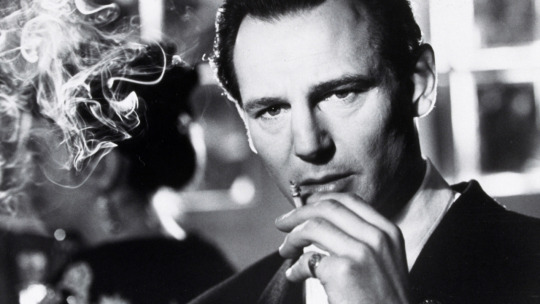
Schindler’s List (1993) dir. Steven Spielberg. 7.6/10 Updated 3 years later (8.8.20) 7.7/10
I like the close up and handheld-like nature of the camera movements when they are all crowded up. Really depicts the chaos.
The background music matches the scenes well. eg. when the red-coat girl is first introduced. Also, the Jewish people walking at the end. The walk is truly so beautiful along with the stone setting.
The gravestone walkway is very well made, but so disrespectful.
I love how Schindler is so respectful by the end. I love it. I love how selfless he had become.
I’m pretty into war films. This is really inspiring in some ways and really devastating in others.
Updated Commentary:
I just love Stern.
Danka is also a cute addition.
Spoiler: [About Oskar Schindler coming to Kraków during WWII. He buys drinks for and gets along well with the German elite. The Jewish people are being forced to wear the Star of David on their arms after registering as Jews. Schindler talks to Itzhak Stern and has him run everything that involves him starting and maintaining an enamelware factory. He wants the Jewish people’s money since they can’t have their own businesses and they can get paid for with actual products. Schindler goes to a church to talk to the Jewish smugglers. They walk out one by one, but Poldek Pfefferberg gets stuck talking to Schindler about providing good products. The Jewish people are forced into the ghetto while Schindler has a nice apartment. Stern eventually gets people to invest and he works for Schindler. The factory is set up and Stern gathers Jewish people after forging documents that deem them as essential workers. They get removed from being sent to camps. Schindler works to find a secretary. Schindler’s wife, Emilie, comes to visit and doesn’t care for his new secretary, Wiktoria Klonowska. Schindler makes the doorman know who his wife is and he goes out to dinner with her. They catch up and he talks of wanting to be extraordinary. She heads home later. Stern has one of Schindler’s workers, Mr. Lowenstein, talk to him to thank him for saving him. Schindler reprimands Stern later since the man has one arm and he doesn’t want to be in this position. Rolf Czurda talks with Schindler about the insignificance of Jews as Schindler wants to be compensated for losing a worker. Lowenstein was shot and killed as the Jewish people were shoveling snow. Schindler learns from Poldek that Stern was put on the list to be on a train. He heads to the station and the clerks don’t help him since his name is on the list and the list isn’t wrong. Schindler gets the names of both men who don’t help him and says they’ll be reinstated to Southern Russia. They start helping him find Stern and they do so as the train leaves. Stern explains to Schindler that he didn’t have his documents on him. The rest of the Jewish people depart as their belongings are sorted into categories. The Jewish people in the ghetto talks about their lives. Amon Göth is driven through the ghetto as he arrives for the start of the Plaszów labor camp construction. He picks out his new helper, Helen Hirsch, from a line of girls. A Jewish engineer, Diana Reiter, reports that the foundation must be torn down and redone or the building will collapse. Göth has his men shoot her and has the foundation redone. Göth addresses his men about the success of the Jewish people and how it will come to an end. They rally the Jewish people to be put on trains as Schindler and his wife watch from afar as they ride horses. The Jewish people hide important belongings, hide themselves in specific hiding spots, and some are killed on the spot. A little girl, Danka, and her mother are helped by Danka’s friend, Adam. Schindler notices a little girl wearing a red coat in the turmoil. Göth occasionally shoots people at random in front of his villa. Schindler joins to eat with the other German elites and meets Göth. He talks to Göth about his empty factory and how he needs workers. Göth discusses with him and allows him to create his own subcamp for his workers. Göth would be getting money in return and has Stern handle everything. Stern works for Göth now and he tells Schindler of important things to know. Göth and his men test the abilities of the workers to see that they are capable. One worker is put to get shot and killed for not making enough products even though he had a reasonable excuse. The guns fail to shoot and he is saved. A man is killed as they try to figure out who stole a chicken. A little boy says the thief was the man who was killed. The boy is hired by Schindler later. A Jewish girl named Regina Perlman goes to visit Schindler and he refuses to meet her after seeing her. She comes back dressing better off and he meets with her. She wants him to hire her parents and that his place is like a
haven. He yells at her until she runs away. He goes to yell at Stern since he’s not here to help people. They also talk about Göth and Stern talks of Göth’s ruthless nature in killing. Schindler has Stern bring over Regina’s parents and Regina is happy when she sees them being transferred. During Göth’s party, Lisiek gets materials from Helen to clean Göth’s bathtub. Schindler appears during this and talks with Helen. She eventually starts talking about her abuse from Göth. Schindler explains to her that Göth is ruthless to those he doesn’t know, but she pleases him. Schindler talks with a drunk Göth about having power by not killing others even if it’s justified. Göth talks to Stern since auditors are looking through his books. He gets upset at his stable boy for not handling his saddle well, but he doesn’t get upset further. Lisiek fails to remove the stains from Göth’s bathtub and he’s allowed to go with no punishment. In a bit, Göth starts shooting at the boy from afar until he’s killed. Helen does his nails as he stares at her. Göth talks to Helen later and praises her and talks to her about her loneliness. He wants to kiss her, but decides not to since she’s Jewish and he beats her. Schindler celebrates his birthday until a Jewish mother and daughter gift him a cake in front of the Germans. Schindler kisses them. The Jewish people talk of a story of being gassed in the showers. Many don’t believe it. The Germans have the Jewish men and women run naked to separate them into the healthy and the unhealthy. During this time, the children are sent away. Some children manage to stay behind by hiding. The parents try to stop their children from being taken away, but are blocked. Schindler convinces the men to hose down the trains to give them water. Göth believes it is evil since it gives them a taste of hope. Schindler is later arrested for having kissed a Jewish woman. Göth convinces the officer that Schindler couldn’t have helped kissing the girl since she was good looking, He offers a bribe to get Schindler released. Göth is to send the Jewish people in Płaszów to Auschwitz. Piles of bodies are burned and the camp is closing. Schindler sees the body of the girl in the red coat. He starts creating a list of his workers to have them released and given to work for his new munitions factory in Brinnlitz. Göth agrees for a bribe, but doesn’t understand as Schindler pays for each individual. Stern helps with the list and says it’s an absolute good. Schindler wants the last name on the list to be Helen and Göth refuses. Göth wants to take her with him, but knows he can’t. The woman and men on the list, including Helen, are put on trains to be transported. The men arrive, but the women are accidentally sent to Auschwitz, because of a paperwork problem. The women realize that they aren’t in the right place as they are forced to have their heads shaved, be stripped, and put into the showers. They are relieved once the showers expel regular water. Schindler arrives to take them after paying Rudolf Höss in diamonds. When Danka is separated from her mother, Schindler confronts the guard and tells him that her small fingers polish the inside of small, metal casings. She is returned to her family. Schindler talks to his SS guards about not hurting his workers. They aren’t allowed in the factory without authorization. Emilie comes to volunteer at the clinic and Schindler promises her that she will always be recognized as his wife now. Stern reports that their products aren’t passing the tests and talks of the rumor that Schindler is re-calibrating the machines. Schindler wants them to not produce real shells and tries to buy other shells to pass as their own. Schindler has his workers observe the Sabbath. Stern reports that Schindler is broke. The news reveal that the war has ended. Schindler addresses all his workers about it and how they’ll begin the process of finding their families tomorrow. He thanks Stern and everyone and talks of how he has to go into hiding now since he’s a member of the Nazi Party and had profited from the
war. He has the guards come in and allows them to either kill the Jewish people or leave as men instead of murderers. They leave. Schindler has them observe three minutes of silence. The Jewish people create a ring for Schindler with an engraving of a Talmudic quote. They also provide him a letter with everyone’s signatures explaining his role in case he is captured. Schindler breaks down to Stern about how he could’ve saved more people. He leaves with his wife. In the morning, a messenger tells them that they are liberated and can go to a friendly town nearby. Göth is hung. The actors and actresses, along with the real survivors, place stones on Oskar Schindler’s gravestone. Liam Neeson puts roses on.]
4 notes
·
View notes
Text
Day 145: Schindler's Factory and St. Mary's Basilica

On our first full day in Krakow, we took a walk out of the central city to see something that Jessica had missed out on eight years ago: the Oskar Schindler Factory Museum. We weren't sure exactly what to expect, but it was highly recommended by all the guidebooks and everyone we'd mentioned it to.
It ended up being one of the most memorable museum experiences of the entire trip.

If you've never seen Schindler's List and don't know who Oskar Schindler was, here is a (somewhat) brief summary. Schindler was a German Czech businessman. He was also a Nazi spy who leaked information to the German army before they invaded Czechoslovakia in 1938. He also aided the Nazi invasion of Poland and was given the lease to an enamelware factory that he could use as a cover--getting rich off of cheap prison labor while continuing to work as a Nazi spy.
He was not a nice guy.

The longer he ran the factory, though, the more his outlook began to change. It started as rational self-interest. Other German factory owners were mistreating their Polish and Jewish workers so badly that it ruined their productivity. But when Schindler gave his own workers plenty of food and refrained from torturing them, his profits grew.

As the Holocaust intensified, Schindler began to actively protect his Jewish workers. For all his other sins, he drew a line at abetting genocide. He hired elderly and disabled Jews who couldn't actually work. He spent more and more of his own money to provide them with food and medical care. He leaked lists of prisoners to outside Jewish organizations and got himself arrested multiple times on suspicion of being a Jewish sympathizer. He bribed the local concentration camp commandant--a sadistic man who enjoyed performing random executions--for permission to move his workers into a private subcamp at his factory. Schindler built and ran the camp as humanely as he could get away with, at his own tremendous expense.

In 1944, Schindler compiled his most famous "list." The Soviet army was advancing into Poland, the Nazis were consolidating their resources, and all non-essential factories were being shut down. The Jewish slave laborers, no longer needed, were being sent off for extermination in Auschwitz-Birkenau. But with yet more bribes and manipulation, Schindler managed to relocate and convert his factory into a munitions factory, sparing it--and his camp--from being shut down.
When the war ended, Schindler was absolutely destitute--and 1,200 Jews were still alive in his camp.
It's an amazing story, but it isn't actually the focus of the museum. In the entire complex that Schindler's enamelware factory once occupied, only the two rooms of Schindler's office are preserved and dedicated to his story. The rest of the museum is an engrossing and immersive experience of Krakow's tumultuous journey through World War II.
It starts with the end of World War I in 1918, when Poland was finally reunited as an independent country. For over a century, it had been divvied up like a shared dessert between the great Continental powers of Prussia (Germany), Austria, and Russia.


Fast-forward 21 years–the Great Depression had hit Poland just like everywhere else, but things are turning around. Krakow is expanding and modernizing under the leadership of an educated liberal government. The people of Poland have great plans, and they are celebrating the anniversary of their independence.


The people are optimistic–excited, even. They still think that Hitler is full of hot air and that if he ever does invade, France and England will come to their rescue and send the Nazis scurrying home. It is August of 1939, and in less than one month, Poland will be back under the iron heel of foreign overlords for another fifty years.

France and England didn't lift a finger to stop the invasion, and the Polish government surrendered before most of their soldiers even had a chance to fight.


The museum was unlike any other we’ve seen before. Rooms were made up to look like streets, shops, and bunkers. Period posters plastered the walls, and we couldn’t help but feel–in a small way–the oppressive unreality of the world that the people of Krakow were suddenly dropped into.



From day one, the German occupation force was intent on wiping out Krakow’s Polish identity and replacing it with a concocted German one. Polish monuments were demolished and replaced with Nazi ones. Polish street signs were torn down and replaced with new names in German Gothic print. The main square, "Rynek Główny," became Adolf-Hitler-Platz.

Reading the transcript of an interview with a German bookseller who had set up shop in Krakow, it seems they genuinely thought of themselves as some sort of cultural evangelists–that the Poles needed only to be shown the light of Hitler’s wonderful vision and would happily fall in line.

When it quickly became clear that this wouldn't happen--which was probably the plan all along--the Poles simply became another problem in need of a solution. Radios and independent newspapers were banned. Civilian travel was restricted, and those caught trying to smuggle food into or out of Krakow were beaten and sent to labor camps. Universities and seminaries were shut down, and their professors were sent to labor camps. Polish children were to be raised as an uneducated slave race, utterly subservient to their German masters and ignorant of their own cultural heritage.



From the age of 14, all Poles were required to work 60 hours per week. Their jobs were printed on their IDs and could not be changed without government approval. Those without jobs were required to report to the government for job assignment, and anyone caught without an employment card was arrested and sent to Germany as an indentured farm labor. Around 13,000 Cracovians were deported in this manner.


Meanwhile, even the smallest infraction or insubordination committed by a Pole was punishable by death. "If I had to put up a poster for every seven Poles shot," the Nazi governor-general boasted, "the forests in Poland would not be sufficient to manufacture the paper." Loudspeakers set up throughout the city continuously announced the names of people who had been sentenced to death.
Even as the crackdowns became bloodier and bloodier, the occupied government issued propaganda celebrating the increasingly friendly relations between Germans and Poles.

When France surrendered to Germany in June of 1940, dozens committed suicide in Krakow alone.

But the Poles didn't bend over without a fight. Teachers hosted illegal night classes, protesters printed counter-propaganda in their kitchens, and homeowners hid weapons for the Resistance.


The museum then dove into the Jewish experience of Krakow's occupation. At first, most of the city's Jewish population was simply driven out of the city. Krakow had been made the capital of the German-occupied government, and the prospect of high-ranking German officials having to even see Jews in their daily lives was unthinkable. Over several months, more and more Jews were ordered to leave, and they were allowed to take less and less with them.

Eventually, the remaining Jewish population of the city was relocated to the designated ghetto and literally walled in. For years, the Nazis had been running a propaganda campaign claiming that Jews carried disease, and the move was justified as a public health emergency. The governor-general publicly celebrated the formation of the ghetto and told Germans to write home and reassure their families that things are getting better with "the lice and the Jews."

The ghettos soon became a health emergency, however. Around 17,000 Jews were expected to live in 320 houses. They were issued rations of less than 300 calories per person per day, and anyone who failed to maintain employment was "deported" to the nearby Płaszow forced labor camp . Any Jew caught trying to escape the ghetto was executed on the spot.

Finally, in March 1943, the ghetto was liquidated without warning, and all of the Krakow's remaining Jews were transported to Płaszow.


At Płaszow, thousands of Jews, Poles, Ukrainians, and Romanies were worked to death in the quarries. Despite the constant inflow of prisoners, the population stayed relatively constant between eight and ten thousand. In the summer of 1944, as the Soviet Army was bearing down on Krakow, the Nazis destroyed the camp to hide what they had done. Corpses were dug up, incinerated, and scattered. Survivors were sent west for extermination in Auschwitz.


The museum culminates with a walk through the fall of Krakow to the Soviets. The Germans had heavily fortified the city with weapons caches and concrete bunkers, and the generals were confident that the city would not fall. But when the Soviets finally arrived, they took the city in a single day with minimal fighting.


We were coming to the end of the museum, but this was far from the end of Krakow's suffering. The city had simply changed hands from one foreign oppressor to another. The museum ends with an unsettling walk through a dark, featureless corridor that opens into a monument to the Jews of Krakow and the Poles who helped them.

We were moved far more deeply than we'd expected, and our walk back into town was somber. We stopped for lunch at a counter-service restaurant that our host had recommended. We had breaded pork cutlets and fried meat pierogis (a type of dumpling similar to Chinese potstickers or Japanese gyoza). It was simple, cheap, and absolutely delicious.

And of course, there were those impossibly folded, parchment-thin napkins.



We made our way up into the old town from the south, passing by Wawel Castle and many churches. We took another stroll through the market hall, which was mainly filled with amber jewelry and wooden chess sets. Poland is one of the world's largest sources of amber. I'm not sure about the chess sets.

Hot and footsore, we stopped for a rest and iced coffees at a café, then decided to make one last stop before heading home for an early evening.

As familiar as Jessica was with the history and legends of St. Mary's Basilica, she'd never had a chance to actually go inside on her last visit.

It was stunning. At almost every cathedral we visited in Europe, we'd heard stories of how the walls and statues used to be brightly colored before they were whitewashed during a relatively recent wave of conservatism. St. Mary's is an eye-opening example of one that was never whitewashed.


For a major Gothic church, St. Mary's isn't especially large or architecturally complex. It is made of brick instead of stone--a sure sign of an unwealthy congregation. But the joyfully painted, carved, and gilded artwork adorning virtually every surface of the interior transforms the space into something almost otherworldly.

Looking up at the intricately carved wooden altarpiece, backed by colorful stained-glass windows and flanked by brightly painted and patterned walls–one can’t help but need to sit down and soak it all in with slack-jawed awe.
Next Post: Auschwitz
Last Post: Going East
1 note
·
View note
Text
A Legacy of Life…
A Legacy of Life…
In Krakow during World War II, the Nazi Germans force local Polish Jews into overcrowded ghettos. Oskar Schindler, a member of the Nazi Party from Czechoslovakia, acquires a factory to produce enamelware. His workers were all Jews. Schindler is careful to maintain his “favored” relationship and friendship with the SS, mostly through bribes. As the war effort for Germany goes bad, he is ordered…

View On WordPress
1 note
·
View note
Link
Check out this listing I just added to my Poshmark closet: World Market Vintage Porcelain Flour Canister Storage Farm House Country EUC.
0 notes
Text
The Problem of "Christian" Art
The Problem of “Christian” Art
“It is a common mistake among artists … to feel that their work must be explicit in spreading and teaching the faith.” public domain Oskar Schindler Following the Nazi invasion of Poland in 1939, property and businesses belonging to the Jewish population were seized by the regime. One of these factories, specializing in the production of enamelware, was obtained by a German industrialist named…

View On WordPress
0 notes
Photo

for sale #boutiqueetsy : Big Antique German artdeco enamel coffee pot w geometric design enamelware cafetiere, farmhouse country cottage kitchenware kitchen decor #orange #marron #kitchenware #enamelcoffeepot #vintageenamelpot #enameledcoffeepot #frenchcoffeepot #vintageenamelware #artdecocoffeepot https://etsy.me/3dRv7u0 https://www.instagram.com/p/CXgpdkmomOT/?utm_medium=tumblr
#boutiqueetsy#orange#marron#kitchenware#enamelcoffeepot#vintageenamelpot#enameledcoffeepot#frenchcoffeepot#vintageenamelware#artdecocoffeepot
0 notes